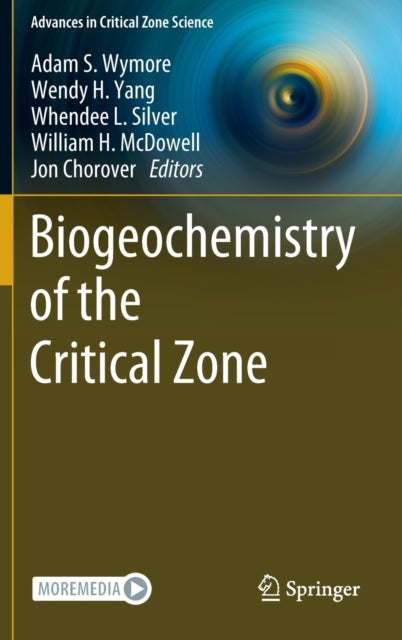Shulph Ink
Biogeochemistry of the Critical Zone
Biogeochemistry of the Critical Zone
YOU SAVE £21.71
- Condition: Brand new
- UK Delivery times: Usually arrives within 2 - 3 working days
- UK Shipping: Fee starts at £2.39. Subject to product weight & dimension
Bulk ordering. Want 15 or more copies? Get a personalised quote and bigger discounts. Learn more about bulk orders.
Couldn't load pickup availability
- More about Biogeochemistry of the Critical Zone
This book highlights recent advances in biogeochemistry that have resulted from the development of critical zone science. The critical zone (CZ) is an open system in which energy and matter are transported and transformed, and it is shaped by tectonic, lithologic, hydrologic, climatic, and biological processes. Biogeochemical processes control the quantity and quality of carbon and nutrients available for living organisms, the retention and export of nutrients, and the ability of ecosystems to sequester carbon. The book provides both reviews and original research contributions that incorporate a CZ framework to test biogeochemical theory and develop new and robust predictive models.
Format: Hardback
Length: 202 pages
Publication date: 17 May 2022
Publisher: Springer Nature Switzerland AG
The earth's critical zone (CZ) is a vast and intricate region that extends from the weathering front to the top of the vegetative canopy, encompassing a range of geological, hydrological, and biological processes. It is defined by the lowest extent of freely circulating groundwater and the weathering front, and its structure and function are shaped by tectonic, lithologic, hydrologic, climatic, and biological factors. The CZ is an open system in which energy and matter are both transported and transformed, and it plays a crucial role in sustaining a habitable planet.
Biogeochemical processes are at the heart of energy and matter fluxes through ecosystems and watersheds. They control the availability of carbon and nutrients for living organisms, the retention and export of nutrients, and the ability of ecosystems to sequester carbon. However, studying these processes is complex due to the interdependence of biological, chemical, and physical processes. The authors of this book aim to provide a unifying framework for understanding these interactions by incorporating a CZ framework into their chapters.
The book includes both reviews and original research contributions that test biogeochemical theory and develop new and robust predictive models regarding elemental cycles. The chapters cover a wide range of topics, including soil biogeochemistry, hydrology, pedology, microbiology, and ecosystem ecology, and they demonstrate how the CZ framework can be applied to these fields.
One of the key strengths of this book is its interdisciplinary approach, which brings together experts from various fields to explore the complexities of the CZ. The authors highlight the importance of integrating knowledge from different disciplines to better understand the processes that control biogeochemical cycles and fluxes of energy and matter. They also emphasize the need for interdisciplinary collaboration to address the challenges facing the CZ, such as climate change, land use change, and pollution.
Another notable feature of the book is its emphasis on developing new and robust predictive models that can be used to understand and manage the CZ. The authors discuss the challenges associated with modeling complex systems, such as the CZ, and they provide examples of successful modeling approaches that can be applied to different aspects of the CZ.
Overall, this book is a valuable resource for researchers, students, and policymakers interested in understanding the biogeochemical processes that control energy and matter fluxes through ecosystems and watersheds. It provides a comprehensive and interdisciplinary approach to the CZ, and it highlights the importance of integrating the CZ in sustaining a habitable planet.
Weight: 489g
Dimension: 235 x 155 (mm)
ISBN-13: 9783030959203
Edition number: 1st ed. 2022
This item can be found in:
UK and International shipping information
UK and International shipping information
UK Delivery and returns information:
- Delivery within 2 - 3 days when ordering in the UK.
- Shipping fee for UK customers from £2.39. Fully tracked shipping service available.
- Returns policy: Return within 30 days of receipt for full refund.
International deliveries:
Shulph Ink now ships to Australia, Belgium, Canada, France, Germany, Ireland, Italy, India, Luxembourg Saudi Arabia, Singapore, Spain, Netherlands, New Zealand, United Arab Emirates, United States of America.
- Delivery times: within 5 - 10 days for international orders.
- Shipping fee: charges vary for overseas orders. Only tracked services are available for most international orders. Some countries have untracked shipping options.
- Customs charges: If ordering to addresses outside the United Kingdom, you may or may not incur additional customs and duties fees during local delivery.


